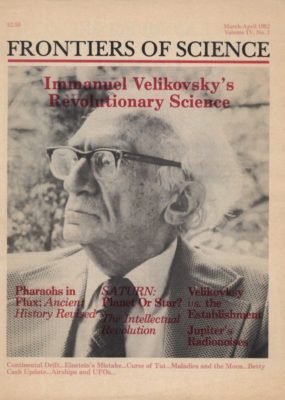Frontiers of Science was a magazine published by William Bonner (Agora Publishing, Baltimore) and edited by Elizabeth Philip.[1]Alfred de Grazia, Cosmic Heretics (1984) Metron Publications, USA. ISBN 0-940268-08-6. (p.412) It included a special issue, “Immanuel Velikovsky’s Revolutionary Science”, published March-April 1982 (Vol.IV No.1)
Comment
Alfred de Grazia writes:
“What was true for book-publishers held also for magazine publishers. The only magazine with a general readership that gave sympathetic attention to quantavolution was Frontiers of Science, edited by Elizabeth Philips. It failed after several years because it was part of a conglomerate operation that used the bottom line to weed our unprofitable properties.”[2]Ibid. grazia
Contents
- Editor’s note
- Immanuel Velikovsky . . . . . . . . . . . . . . . . . . . . . . . . . . . . page 17A brief biography of a brilliant, controversial thinker.
- Revolutionary Ideas . . . . . . . . . . . . . . . . . . . . . . . . . . . . . page 15by Lynn E. Rose
What is the nature of a revolution in science? Is it founded in new facts-or new ideas? Velikovsky, says Professor Rose, belongs in the tradition of the great Renaissance thinkers who inspired Galileo and other scientists to challenge the orthodox world view..
- More Evidence . . . . . . . . . . . . . . . . . . . . . . . . . . . . . . . . . . page 20by Immanuel Velikovsky
Who were the mysterious horsemen who overran Egypt? Was the Queen of Sheba also the female pharaoh Hatshepsut? What really happened during the Dark Ages of Greece? Fascinating, new archeological and textual discoveries support Velikovsky’s revision of the history of the ancient Near East
- Night Sun page 29by Dwardu Cardona
In ancient Babylonian texts, Saturn is referred to as a sun Scholarly research identifies Saturn with the “first god” of many ancient peoples, including the Hebrews. Was Saturn once a bright star-planet? What caused its light to dim?
- Noises from Jupiter . . . . . . . . . . . . . . . . . . . . . . . . . . . . . . page 33by Immanuel Velikovsky
Astronomers accidentally discovered radio emissions from Jupiter in 1555. In this article Velikovsky explains the theory that led him to predict in 1953, that such radio-noises would be discovered
- Words in Collision . . . . . . . . . .by C. Leroy Ellenberger
Velikovsky’s ideas have touched off violent attacks from the scientific establishment. Several major arguments against Velikovsky are reviewed and answered, leaving “critics in chaos.”

